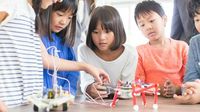The educational potential of after-school clubs in Japan is set to undergo a significant transformation, emphasizing the importance of STEAM (Science, Technology, Engineering, Arts, Mathematics) education. Norihito Yasuno, an AI engineer and author of the new book "1% no Kakumei" (1% Revolution), argues that these clubs can be pivotal in reinventing educational practices outside the formal school system.
Currently, after-school clubs serve as safe havens where children can play with their peers until their parents retrieve them. Yet, these facilities have largely maintained outdated methodologies, failing to capitalize on their opportunity to bridge educational gaps. Yasuno explains, “The current after-school clubs are mostly places for recreation rather than learning, but they hold tremendous potential for educational enhancement.”
Yasuno emphasizes the significant impact of implementing STEAM activities in these settings. He cites the successful model of "Mimimi Labo" in Kanazawa City, which offers teenagers access to cutting-edge technology, including programming robots, 3D printers, and computer software for creative projects. Yasuno envisions a similar framework that could be adapted throughout Japan’s after-school facility landscape to facilitate tech-savvy learning environments.
“Incorporating STEAM subjects not only informs students about these fields but also sparks creativity and innovation,” he adds. By offering diverse learning opportunities, these clubs can cater to the unique needs of each child, ultimately fostering a more inclusive educational atmosphere.
The challenges faced in implementing these educational changes are significant. Yasuno notes that traditional school systems often resist new methods due to bureaucratic hurdles and administrative overloads. “Implementing innovative strategies in the rigid structure of schools poses difficulties,” he points out, advocating instead for more flexibility in after-school programs to introduce new educational content. This presents a unique opportunity since after-school clubs operate with more autonomy.
Yasuno's insights shine through in his promotion of the "Mitou Junior" program, which supports young creators from elementary through high school with their distinctive ideas and abilities. This initiative encourages students to submit proposals on issues they encounter in their daily lives and how they might tackle these through technology. “The application developed by Ueda Kota, who has selective mutism, demonstrates how personal challenges can lead to innovative solutions,” Yasuno explains, sharing the journey of Kota who successfully created an app that facilitates communication for those facing similar challenges.
Moreover, the disparity in educational access continues to be a pressing concern across regions. Yasuno advocates for a national subsidy system, proposing a monthly voucher system for all families aiming to ease financial burdens incurred by extracurricular education. “This would help ensure that children from all backgrounds have the chance to engage in diverse learning experiences,” he suggests, pointing to similar efforts underway in Osaka City, where support is provided through approved learning programs.
As Japan faces a gradual shift in the expectation of junior high school students transitioning into community-based club activities, Yasuno sees this as a crucial moment. "This transition allows children to define their own educational paths during after-school hours, making it essential for local governments to step in with effective support structures. We must create a viable learning environment that extends beyond traditional classroom walls,” he advises.
In his articles and public speeches, Yasuno champions a holistic approach to education that not only recognizes academic achievement but also emphasizes the importance of emotional and social development. He believes that innovative educational practices should inspire creativity and foster environments where young minds can flourish through hands-on projects and collaboration.
The potential of after-school clubs to educate children in STEM-related fields stands as a crucial development in Japan’s educational landscape. Yasuno contends that with the right policies, community involvement, and visionary leadership, these programs can evolve into invaluable resources for future generations. It is this vision of creating supportive, technologically advanced, imaginative spaces that Yasuno hopes to advocate through his work and initiatives linked to creating a better educational future for all.
In conclusion, the integration of STEAM education into after-school programs represents not just a tactical shift in pedagogy but a fundamental rethinking of how educational values can be imparted beyond conventional methods. Yasuno’s ideas present a roadmap to bridge divides, enhance learning experiences, and empower a generation equipped with skills necessary for tomorrow's challenges.

